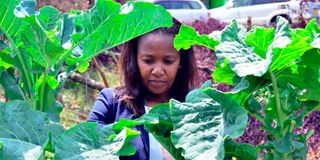Musings from city man in village

Ministry of Agriculture, Livestock, Fisheries and Cooperatives Chief Administrative Officer (CAS) Annie Nyaga examines kales grown at a model kitchen garden at the ministries grounds on October 15, 2020.
What you need to know:
- Growing crops has become a very expensive affair for the simple reason that these days they are attacked by many more pests than ever before.
- Today, try growing vegetables on your kitchen garden without using chemicals and you won’t know what hit you.
Whenever I feel uncomfortable with the direction our politics is taking, and whenever I see two arms of government waging unnecessary wars the way the Executive and the Judiciary have been doing, whenever I sense that an otherwise precedent-setting judicial verdict has been rendered suspect due to what appears to be personal vendetta, I do what comes naturally to mind; I retreat to the rural areas where I can think long and hard about nothing in particular.
This mind-healing experience is one I would recommend for everyone but, alas, not everyone can partake of it, for the simple reason that few people can take a weekend off to their rural area. Not if it is 300 kilometres away, for instance. The reason the rural areas are a perfect recreation setting for some of us is that you can decide not to watch television or listen to the radio, avoid social media, and even elude the local newspaper vendor because if you don’t see the day’s headlines, you’ll still survive.
This deliberate hermit-like existence can only last a day or two, of course, for if idleness doesn’t kill you, ignorance surely will, but there is something to be said about switching off now and then and deciding, instead, to commune with nature. This is fitting now because the weather is so accommodating and the countryside has become verdant and pregnant with promise. In many areas, the maize is growing lustily, healthy tendrils are sprouting exuberantly from all sorts of legumes, and the countryside will soon break into flower.
The old cash crops -- coffee and tea -- are competing for space with the new – avocados, bananas, and three-month vegetables like spinach, sukuma wiki, terere, managu, and all sorts of spices, while the livestock are lowing contentedly because they have plenty to eat. But of course God works in mysterious ways, and while many peasant farmers are rejoicing because the rains have been plenty so far, others are shedding tears because their homes, crops and livestock have been swept away by floods and they do not know what to do.
This is hardly the space for a treatise on the vagaries of climate change, but the ineluctable fact is that some Kenyans are bound to go hungry a month or two after the next harvest as has happened in the past. Agricultural experts have wrestled with this phenomenon without much success, but it is just one of the unfortunate things that make farming particularly unrewarding especially for peasants. Why is this so?
Axax
First, growing crops, vegetables and fruits of any nature has become a very expensive affair for the simple reason that these days they are attacked by many more pests than ever before. In the old days, for instance, it was rare for a farmer to lose an entire crop to army worms, locusts or aflatoxin-producing molds. The only menace used to be birds which have through the ages reaped where they never sowed, but matters are different today.
Today, try growing vegetables on your kitchen garden without using chemicals and you won’t know what hit you. Multitudes of white flies, fruit flies, beetles, snails, aphids, mites, weevils, cutworms and all sort of vermin will invade the shamba as though they own shares in it, and before you know it, there is nothing to harvest. This is why experts estimate that pests account for at least 25 per cent of food losses worldwide.
To make matters worse, if you do use chemical sprays to keep your crop healthy, chances are it will be rejected in the market. Certainly, it won’t find its way into the export market where the real money is. Commodity importers have ways of detecting what kind of pesticide you used and the quantity, and they won’t allow anything that offends the delicate palates of their consumers, especially if it is sourced from Africa. Never mind that many of those pests must have originated from those same cold climes and flourished in our continent because the environment is naturally hospitable. One of the biggest problems in this regard is that there is no way to control these pests without pesticides, and the method recommended by agriculturalists, crop rotation, is impracticable if your land is less than an acre.
Besides the devastation wrought by pests, it is now emerging that post-harvest losses are an even greater threat to food self-sufficiency especially in Africa. It is estimated that every year, more than a third of all the food produced is lost through poor or non-existent storage after harvest. This is a serious issue especially in parts of the world which are already food insecure.
In Kenya, it is easily predictable that even if the harvest is bountiful this season, whole communities will still have to rely on food aid sooner or later. This is because individual farmers, even in the grain basket of the North Rift, are unable to store their maize for any length of time, and they lose plenty every season. Perhaps it is time the government looked at this matter more seriously and expanded its food storage capacity.
Mr Ngwiri is a consultant editor; [email protected]





